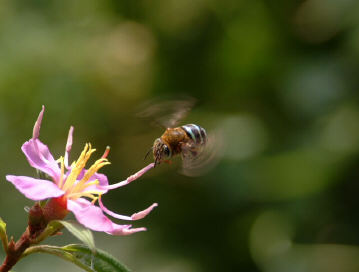Necessary
equipment...
-
Any
COOLPIX camera (but of course).
-
Alarm
Clock. I am not kidding! You have to get up earlier to get close to them
– lots of them! They become very active in the afternoon and disappear
later. My favourite time is early in the morning after rain. We will find
plenty of beautiful wet flowers to capture, not only insects.
-
External
speedlight. We need a good natural light for many kind of photography but
a speedlight is compulsory in shaded area or poor lightning and for fill
flash. I always bring my SB-50DX with Sto-Fen Omni-Bounce attached.
-
A
mirror, flashlight and dark paper sometimes help.
-
A
tripod or monopod. BSS or Continuous mode features does their job very
well. Forget about that equipment, unless we want to capture flying
insects with Continuous mode and telephoto.
Setting
up your camera...
•
Sleep Mode: Make it 30 minutes! You don’t want to miss that shot because
your camera is in a sleep mode.
•
BSS or Continuous Mode: Use BSS feature if you want to shoot still insect in a
good natural light without tripod. To capture flying insect use Continuous
Mode and mount the camera with telephoto attached (if you have one) on a
tripod to get sharp images.
•
Aperture: Depth Of Field is the key here. Always use a small aperture (higher
f/-number). First, set the camera to Aperture-priority, meter the aperture to
the smallest and note the shutter speed adjusted by camera. Use speedlight or
raise the sensitivity (ISO) if the shutter speed is not fast enough (1/60
seconds is the lowest for some). Set the camera to Manual or Shutter-priority
and raise the shutter speed to freeze flying insects. Leave the Metering to
Center-Weighted.
•
Focus option: Zoom the camera out a little until the macro close-up icon turns
yellow. Select Manual in AF Area Mode under Focus Option and focus on their
head or eyes. It’s a plus if you can make the wings or tail focused as well.
Get as large DOF as you can.
•
Exposure Compensation: We easily overexposed images when shooting macro
photography. Under exposed image is better that having a blown-out highlight
image. So lower the Exposure Compensation value (EV) a little and brighten the
image later with Photoshop, NikonView or other software.
The
use of the equipment...
-
Tripod/
monopod: It is painful to carry this three legged thing around chasing
insects, but you need to mount your camera on it if you attach telephoto
or natural light is not sufficient to have a fast shutter speed.
-
Speedlight.
Built-in and external: Raise the camera shutter speed, set the external
speedlight as slave - off camera and angle it with your left hand to
illuminate the object and to provide better lightning or 3D look. Some
insects can be captured nicer with external speedlight mounted on the
camera, some looks better with both built-in and external speedliight
fires. Reduce the variable power if the object gets overexposed. You may
also adjust both speedlight manually to have different variable power.
-
Mirror
and dark paper: Depends on the insect, decide from which side you want to
capture. If we cannot get a good angle to capture, use swivel LCD or use
mirror and focus on the reflection. If the backgrounds too distracting use
dark paper to cover it up. Do it slowly, it also helps to confuse the
insects sometimes. Mirror or dark paper can also be use as an additional
light or to block a direct bright sunshine.
-
Flashlight:
It helps our camera to focus in lower light or when doing night
photography. They amaze me many times. I found so many interesting
creatures working night shift.
Know
their behaviour...
•
Dragonflies: This one is the easiest for me to capture but almost
impossible for some who don’t know the trick yet. They always land on the
same spot. Wait until it lower or fold their wings, get closer from their back
and slowly move to its side or in front of it. If it flies just wait there and
get your camera ready until it returned – but don’t blame me if it
won’t.
•
Butterflies: I always have a hard time to get close to this beautiful
shy creature. Use telephoto and capture from a distance – works for me.
•
Caterpillar: Look for this crawling weirdo behind leafs. If the
background doesn’t look pretty, move it with a leaf or a stick to a
colourful and nicer leaf and scene. Please return it back to where you found
it.
Friendly
note...
•
Don’t disturb or kill any of the insects you found. Good photographers
don’t do that.
•
If you can find them right in your own backyard, consider yourself as lucky.
Many of us who are living in the concrete jungle have to find them in the
park.
•
The pros typically shoot dozens of shots to get a few keepers. Our camera is a
digital; shoot as many frames as possible to get more keepers than the pros.
•
If you cannot get close to the insects, it is alright – perhaps not just
yet. Just capture them from a distance and crop the image later. Our camera
has more than enough pixels. The whole world know that our COOLPIX can be as
close as 2~3 cm from the object. Keep practicing and learn their behaviour
well and of course have patience! You need a lot of it.
Happy shooting!
With very warm regards,
Bimo.
PS. I am not an
expert, feel free to add your tips and your experiences in insects/macro
photography to the Forum thread linked below. I hope this tutorial is useful
and helps other new members in the future.
